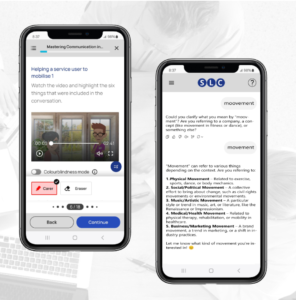
SLC win Ufi grant to develop AI language learning app for social carers
We’re delighted to have won a grant from Ufi VocTech Trust to develop an AI-driven technology solution that provides cheap phone-based language and communication skills

These tips are designed to help you understand the format of the test, the way it’s assessed and the skills you need to use to succeed.
In the writing sub-test, you have 45 minutes to plan and write a letter from the perspective of someone in your profession. The recipient (the person you’re writing to) is usually another medical professional, for example a GP, specialist, nurse, physiotherapist etc. You are given a set of case notes and a task to base your letter on. For the first five minutes of the test, you are not allowed to write anything, including notes or marks on the question paper.
When composing your letter, keep the purpose of the letter in mind. Think about the recipient at all times – their profession, their relationship to the patient and their role in the case. This will help you to select information that is relevant and omit information that isn’t and inform the kind of language you use to communicate your message. This is the most important piece of advice for OET writing.
The following summary of the assessment criteria contains many more tips for success in every area of the sub-test.
There are six criteria that OET will use to assess your writing. Each criterion is awarded a band score; purpose is marked on a scale of 0-3 and all the others are marked on a scale of 0-7. Many students place a high value on “correct English”, or the absence of grammar and vocabulary errors, and while this is important, there are many other things to consider when deciding if your writing is at the right standard for the grade you need.
This criterion examines how clear the purpose of the letter is. You should make the purpose immediately clear so that the reader has a clear idea of what the letter is about early on. For example, follow up care, urgent admission, referral for physiotherapy etc. The specific details and instructions for the purpose should be expanded later in the letter.
This criterion assesses whether the candidate has included all the key information and that it is accurate. Keeping the purpose of the letter and the reader in mind is essential. To assess your own performance in this area, ask yourself these questions:
This criterion examines how clearly you have communicated the information in the letter and how effectively you have summarised the case notes. It looks at whether or not you have included unnecessary information and how far these irrelevancies distract the reader from the main purpose of the letter.
You should also consider the length of your letter. Although you will not lose marks for going over or under the recommended word count, it’s likely that if you write fewer than 180 words, you will have left out some important information or not transformed the notes adequately into sentences, and if you write a lot more than 200, you have probably included irrelevant details.
This criterion looks at your awareness of genre. You should write in a clinical and factual manner and not include opinions, feelings or judgements. Remember that professional writing is formal without being complicated – for example, it’s best not to use contractions like I’m, you’ve and hasn’t, as these are a little too familiar for a formal letter. But at the same time, a phrase like due to the fact that (which means the same as because, but takes five words to say!) makes the recipient work too hard to understand you. Focus on making the meaning clear and avoid using unnecessary words.
You should also consider the urgency of the situation (serious illness or injury requires stronger language than a minor condition or lifestyle issue). Choosing the most appropriate language to request or report this information is very important.
Language must also be chosen which the reader will be able to understand. Abbreviations can be used but OET recommend using them sparingly and only if the recipient would be sure to understand them.
This criterion assesses whether the overall layout of the letter is appropriate – for example, date, address, reference etc. It also examines effective use of paragraphing and how well the information is organised. To make your letter easier to read, leave a clear line between each paragraph.
This area looks at overall organisation as well as organisation within a paragraph. Key information should be highlighted so that it can be found easily by the reader.
There is no one way to organise a letter and different case notes might require a different way of structuring the information. It’s important to be flexible and approach each set of case notes individually. For example, for one set of case notes, it might be logical to report the information chronologically, whereas for another case, it could be better to organise the information thematically – group together information about medical history in one paragraph and information about contributing lifestyle factors in another.
As well as writing professionally and effectively, you should also strive to write as accurately as possible. This criterion covers the areas of language such as grammar, vocabulary, spelling and punctuation. It assesses how accurate the language is, that is has been used appropriately, and whether errors affect the clarity of the message or the speed of information retrieval.
It’s important to use a variety of tenses and forms, but it’s even more important to show that you know how and when to use each one. Look at sample responses to OET writing tasks – or any piece of formal writing – and notice the use of features like conditionals, relative clauses and the passive voice. You should also revise tenses and verb forms and look for opportunities to use them in your writing. For example, describing two events at different times might allow you to use the past simple and past perfect in sentences like “Ms X was prescribed candesartan for hypertension on September 1st. She had previously been given ramipril but had experienced negative side-effects.”
Minor errors will be accepted, but this criterion examines how much the errors affect communication and if they cause strain for the reader.
Improving your spelling, like so many other things, is a question of practice: when you review your work or receive it back from your teacher, make a note of any spelling errors and review them from time to time. Writing on a computer with a spellchecker can be useful, but you won’t catch all your mistakes this way – if you write then instead of than or pane instead of pain, the spellchecker won’t notice, because you’ve chosen the wrong word but spelled it correctly. You also need to make sure that you copy words accurately from the case notes – common errors occur with the names of people and places and specialist vocabulary – so make sure you leave enough time at the end of the test to check your writing for mistakes.
English punctuation is relatively straightforward, and for most letters you will only need to use full stops, commas and apostrophes. There are lots of short, simple punctuation guides online and it’s worth spending some time studying them.
SLC was the OET-accredited Premium Preparation Provider in Europe and is the leading provider of OET preparation services to the UK National Health Service.
SLC offers a wide range of OET preparation services, including self-study, tutoring, practice tests, and writing correction.
Get updates and get the latest materials on Medical English, OET and IELTS

We’re delighted to have won a grant from Ufi VocTech Trust to develop an AI-driven technology solution that provides cheap phone-based language and communication skills

We’re delighted to announce a partnership with leading Medical English app, Doxa.
